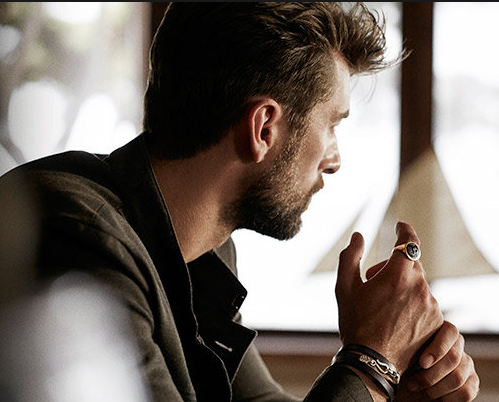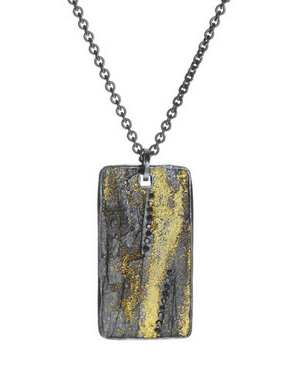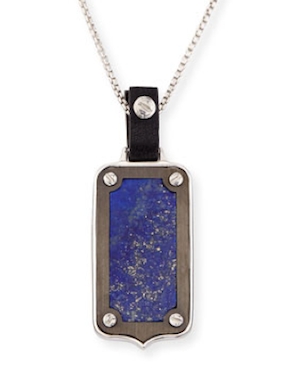
We’ve heard this before, but I’ve been seeing it in real life for a while. Now there appears to be solid evidence.
Judging from new research on global search terms, demand for men’s jewelry is rising significantly.
By far, the biggest demand is for men’s rings – especially wedding rings. With Friday’s Supreme Court decision legalizing gay marriage throughout the U.S., you can expect that trend to go through the roof in the next year.
And while interest in jewelry is lower overall for American males, it appears to be rising at exactly the same rate as the rest of the world. There was a 22 percent increase in searches for men’s jewelry last year over the year before.
What I found most significant is that non-conventional forms of men’s jewelry saw the sharpest increase. Conventional fine jewelry for men, the stuff that works in the boardroom and civic functions – cufflinks and tie bars – saw a slight increase (10 percent). But the biggest jump was in searches for men’s necklaces (up 38 percent) and bracelets (34 percent).
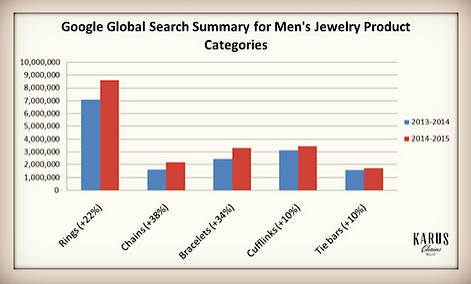 Two years ago, when I was writing a feature on men’s jewelry for JCK, British designer Stephen Webster told me: “Wrist jewelry is having a moment. Worn on either side of your watch or mixing leather, beaded, and silver, a bracelet is probably the easiest jewelry choice for a guy.”
Two years ago, when I was writing a feature on men’s jewelry for JCK, British designer Stephen Webster told me: “Wrist jewelry is having a moment. Worn on either side of your watch or mixing leather, beaded, and silver, a bracelet is probably the easiest jewelry choice for a guy.”
Demand for men’s bracelets was noticeably up then. I knew 40something men routinely wearing a single sterling or palladium link bracelet to the office, often instead of a watch – and I’m not talking about men in the arts. Webster’s bracelets tend to have a rocker edge, like this steel bracelet with thorn motif.
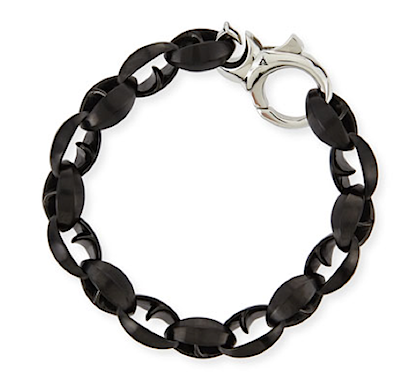
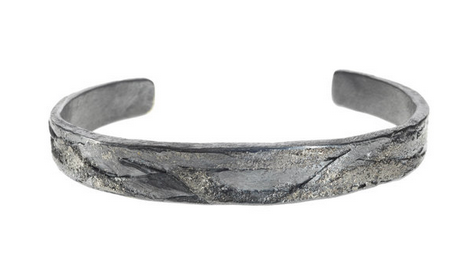 Below that is a cuff of palladium and sterling silver by Todd Reed, who has been adding a little more sparkle to his men’s lines. You can see designers pushing the envelope a bit year by year, playing with that edge where masculinity meets self expression. Reed, who (significantly) is in Colorado not London, imbues this slender cuff with a touch of glitz, even while maintaining a rough-hewn texture that looks decidedly male.
Below that is a cuff of palladium and sterling silver by Todd Reed, who has been adding a little more sparkle to his men’s lines. You can see designers pushing the envelope a bit year by year, playing with that edge where masculinity meets self expression. Reed, who (significantly) is in Colorado not London, imbues this slender cuff with a touch of glitz, even while maintaining a rough-hewn texture that looks decidedly male.
Here’s what Webster and Reed are offering now in men’s necklaces.
Todd Reed men’s necklace of sterling silver with 22k and 18k patina and black diamonds (left) and Stephen Webster reversible necklace of leather and synthetic lapis
If men’s bracelets are now in the mainstream, even in the U.S., I would say the dog tag is what’s currently “having a moment.” Unlike the skull ring, which men who work in offices might save for the weekend, the dog tag pendant can remain under a shirt, a reminder of the weekend to come – with maybe a hint of rebellion revealed at the collar. Fantasy behind the dog tag, fueled by beefcake images everywhere, is a guy peeling off a shirt to reveal something like this dangling between his pecs.
But the big demand, the item that inspired nearly 9 million searches last year alone, is men’s rings. This particular male ornament saw a 22 percent increase worldwide and 25 percent in the U.S. last year. The number of searches overall is nearly triple that of bracelets and cufflinks. Cufflinks, by the way, are still the second most searched form of men’s jewelry, slightly above bracelets.
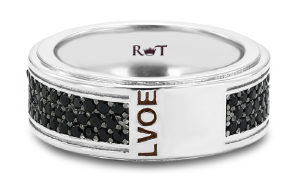 “Wedding” is, by far, the most popular classification, responsible for 45 percent of all searches. It’s highly likely that the legalization of gay marriage in many U.S. states influenced that. Remember: two men purchase rings with every gay-male marriage.
“Wedding” is, by far, the most popular classification, responsible for 45 percent of all searches. It’s highly likely that the legalization of gay marriage in many U.S. states influenced that. Remember: two men purchase rings with every gay-male marriage.
Rings by NYC designer Rony Tennenbaum aimed squarely at the LGBT community (pictured right), are selling like hotcakes at Sparkles, a youthful jewelry store that opened in Chicago just as gay marriage laws were being passed there.
Owner Rachel Meyering says 70 percent of what sells in her store now is men’s jewelry. Her core customers are gay men, many of whom buy their weddings rings and then return later for bracelets. “Some of these couples have been together 20 to 25 years,” says Meyering. “It’s a different world. It’s really exciting.”
But the fact that wedding ring searches are up 19 percent is also an indication that men’s wedding bands are becoming more interesting in general and that guys, including heterosexuals, are taking an active role in choosing them.
Other words that figured in the top 10 search terms for men’s rings: “engagement” (+43%), “gold” (+37%), “silver” (+31%) and “diamond” (+31%). Just missing the top ten search terms: “celtic,” “biker” and “signet.”
Just as an aside, the company that conducted this study seems to have done a thorough job. But the fact that they sell chains may account for why they lumped men’s “chains” with “necklaces.” I’m not yet convinced we’re undergoing a renaissance of men’s chains, history of which I sketched out in A Short History of the Chain (excerpt below). Feel free to correct me if I’m wrong.
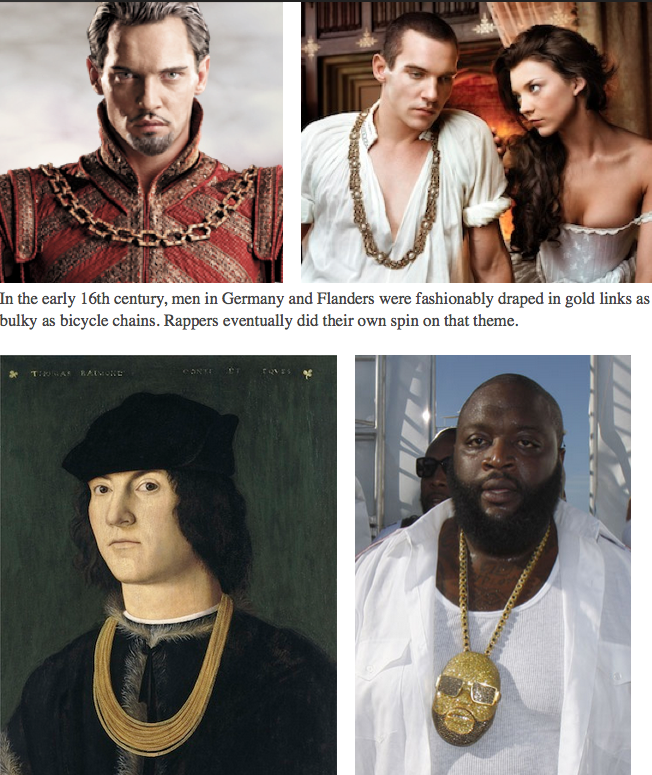 Years ago, I observed men tend to wear jewelry according to an archetype. I classified those as gent, beefcake, real man and rock star. Rocker was clearly the popular choice, at least on this site, as reaction to this post and follow-up posts indicated.
Years ago, I observed men tend to wear jewelry according to an archetype. I classified those as gent, beefcake, real man and rock star. Rocker was clearly the popular choice, at least on this site, as reaction to this post and follow-up posts indicated.
With a new generation of men who’ve come of age piercing and tattooing ornament on to their bodies – and the official sanction of alternative lifestyles heralded by last week’s ruling – perhaps we’ll see less accessorizing as role play and more individual self expression. I’d like to think we’re at the dawn of a new era: freedom of expression for all – women and men, young and old, gay and straight, white collar, blue collar, no collar.
I hope to see more of my favorite designers experimenting with men’s jewelry. It’s always been a tough row to hoe, but the soil has never been more fertile.
Related products

